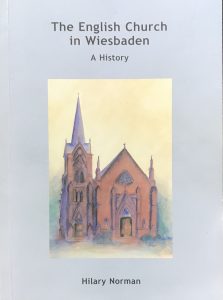Early records show that British visitors to the spa at Wiesbaden began holding Anglican services in 1836 which were conducted in the Mauritiuskirche (until its destruction in 1850) and in other places, such as the Hotel Vierjahreszeiten, the Biebricher Schloss, and later in the Marktkirche.)
The congregation grew rapidly and in 1844 an appeal was made to the Duke Adolf of Nassau and granted for land to build a church. With help from the Kurhaus Trust, the church was built to the designs of Oberbaurat Götz in 1863/4 and consecrated on 22 July 1865. It was named after St. Augustine of Canterbury, who was sent from Rome by Pope Gregory the Great in 597 to convert the English. He later became the first Archbishop of Canterbury.
Frequent visitors to the church during the 1870s and 1880s were two daughters of Queen Victoria, Princess Helena (wife of Prince Christian of Schleswig-Holstein) and Princess Victoria (later Empress of Germany) who often attended the church with her husband (the future Kaiser Friedrich III) and her children, amongst who was the future Kaiser Wilhelm II.
The bell tower and side aisle, designed by architect Friedrich Lang, were added 1887/8. Extensive internal works in 1914 were nearing completion when the first World War began. The British residents left Wiesbaden, but the church continued to be used during the war initially by the remaining American residents and into the early 1920s by a Lutheran congregation. Few records remain following the return of the parishioners in the 1920s, but we know that there were decorated walls, a baptismal font of Nassau marble and seating for 400 people.
The foreign population again left Wiesbaden prior to the onset of World War II and a local lawyer, Dr. W. Adolph, was appointed administrator of the church by the courts. Up until 1943 the building and its contents were damaged by intruders, but Dr. Adolph arranged for the necessary repairs using the funds he had available in the church’s bank accounts.
The church was severely damaged by a bombing raid in February 1945. One object that miraculously escaped damage was the large carved crucifix which hung above the altar. After the war the building was used as a temporary shelter by the American troops and, following restoration in 1950, as their military chapel until 1955 when it was returned to civilian use. In the 1990s the church came under the jurisdiction of the Bishop of the Convocation of Episcopal Churches in Europe. Later a daughter congregation was founded, St. Columban’s in Karlsruhe that we still support today. More recently, we have begun offering monthly worship in Mainz at the Christophskirche.
On 23rd January 1966 a fire caused by a faulty heating system resulted in the church being gutted. Miraculously the crucifix survived again, albeit in a charred state, and it can now be seen at the rear of the church. The wooden rood beam upon which it stood is incorporated into the balcony where the organ now stands. The church was restored and re-consecrated on 22nd January 1967. In 1995 the interior of the church was repainted entirely through the efforts and contributions of members of the congregation and from 2015 – 2020 extensive renovation and improvement work carried out.
If you want to learn more, Hilary Norman, a long-standing member of our congregation and history graduate, spent nine years researching the history of our church from its early beginnings in the 1830s to the present day.

Everything you ever wanted to know about the church of St. Augustine of Canterbury (but were afraid to ask or didn’t know who to ask!!) is here in this book. With over 200 pages and 23 illustrations/photographs, this is the first complete written history of the church.
Copies of the book are €16.00 (excluding package and postage) and available via the church office at parish(at)staugustines.de.
All proceeds from the sales of the book will be donated to the church.
